|
|
|
Sort Order |
|
|
|
Items / Page
|
|
|
|
|
|
|
| Srl | Item |
| 1 |
ID:
126033
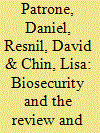

|
|
|
|
|
| Publication |
2012.
|
| Summary/Abstract |
Dual-use research of concern (DURC) is scientific research with significant potential for generating information that could be used to harm national security, the public health, or the environment. Editors responsible for journal policies and publication decisions play a vital role in ensuring that effective safeguards exist to cope with the risks of publishing scientific research with dual-use implications. We conducted an online survey of 127 chief editors of life science journals in 27 countries to examine their attitudes toward and experience with the review and publication of dual-use research of concern. Very few editors (11) had experience with biosecurity review, and no editor in our study reported having ever refused a submission on biosecurity grounds. Most respondents (74.8%) agreed that editors have a responsibility to consider biosecurity risks during the review process, but little consensus existed among editors on how to handle specific issues in the review and publication of research with potential dual-use implications. More work is needed to establish consensus on standards for the review and publication of dual-use research of concern in life science journals.
|
|
|
|
|
|
|
|
|
|
|
|
|
|
|
|
| 2 |
ID:
126487
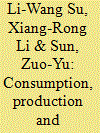

|
|
|
|
|
| Publication |
2013.
|
| Summary/Abstract |
Methanol is considered as one of the potential materials for fossil-based fuels because of its available applications in the fields of fuels and chemical materials. China has become the biggest methanol production country since 2006; hence, analysing the consumption, production and transportation of methanol in China has great importance. In the present article, the current status of methanol from production to consumption in China has been systematically described. Chinese industry and statistics data are introduced to analyse and discuss the total and segmental methanol amount in both production and consumption. In China, most of the methanol is primarily consumed in the synthesis of formaldehyde, alternative fuels and acetic acid, with the corresponding percentages of 35.0%, 33.0% and 8.0%. In 2011, about 22.27 million tons of methanol was generated on site, of which, 63.7%, 23.0% and 11.3% were produced by coal, natural gas and coke-oven gas, respectively. As regards transportation, approximately 82.6% of methanol was transported by overland freight, 9.0% by sea and the rest 8.4% by train.
|
|
|
|
|
|
|
|
|
|
|
|
|
|
|
|
| 3 |
ID:
114677
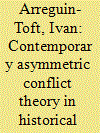

|
|
|
|
|
| Publication |
2012.
|
| Summary/Abstract |
This article offers an intellectual history of theoretical work devoted to explaining asymmetric conflict outcomes since World War II. Three factors are critical to understanding how the literature has evolved. First, the concept of "asymmetric conflict" encompasses a number of overlapping literatures, including insurgency, terrorism, counterinsurgency, and most recently, civil wars. Second, and interrelated, the field of inquiry has been unproductively divided between military and academic thinkers, with insufficient engagement between the two communities. Third, the popularity of the field of inquiry following the events of September 11, 2001, and the subsequent American-led military operations in Afghanistan (2001) and Iraq (2003) have resulted in analyses that are empirically rich, but have provided little in the way of theoretical advances. The conclusion offers an overall assessment of the field of inquiry into asymmetric conflict outcomes, suggested directions for future research, and a table of major contributors to the literature, their key questions, case universes, intended contributions, and theoretical limitations.
|
|
|
|
|
|
|
|
|
|
|
|
|
|
|
|
| 4 |
ID:
168846
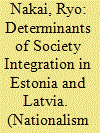

|
|
|
| 5 |
ID:
148123
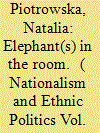

|
|
|
| 6 |
ID:
089991
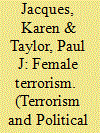

|
|
|
|
|
| Publication |
2009.
|
| Summary/Abstract |
The sharp growth in the number of publications examining female involvement in terrorism has produced a valuable but un-integrated body of knowledge spread across many disciplines. In this paper, we bring together 54 publications on female terrorism and use qualitative and quantitative analyses to examine the range of theoretical and methodological approaches in these papers. Using a content analysis, we identify six primary research foci: Portrayal in media, Feminism, Interviews with terrorists, Group roles, Motivation and recruitment, and Environmental enablers. Results revealed a reliance on secondary rather than primary data, narrative rather than statistical comparisons, and descriptions rather than explanations of events.
|
|
|
|
|
|
|
|
|
|
|
|
|
|
|
|
| 7 |
ID:
177095
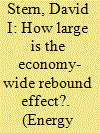

|
|
|
|
|
| Summary/Abstract |
The size of the economy-wide rebound effect is crucial for estimating the contribution that energy efficiency improvements can make to reducing greenhouse gas emissions and for understanding the drivers of energy use. Economy-wide rebound from an energy efficiency improvement includes changes in the use of energy to produce complementary and substitute goods or inputs and other flow-on effects that affect energy use across the economy as well as the direct rebound due to energy users using more of an energy service that has become less costly as result of improved energy efficiency. Jevons first argued in 1865 that improvements in energy efficiency increase total energy use, and in recent decades researchers have argued for and against this “backfire” hypothesis. Theory provides some guidance on the factors affecting rebound but does not impose much constraint on the range of possible responses. Historical evidence suggests that the improved energy efficiency of recent technology has not reduced energy use because consumption has shifted to more energy-intensive goods and services. Simulations and econometric research have produced mixed results. Some recent general equilibrium studies find large rebound, around 100%, but more research is needed to confirm or refute these findings.
|
|
|
|
|
|
|
|
|
|
|
|
|
|
|
|
| 8 |
ID:
096724


|
|
|
|
|
| Publication |
2010.
|
| Summary/Abstract |
Climate change will impact electricity markets through both electricity demand and supply. This paper reviews the research on this topic. Whereas there is much that remains unknown or uncertain, research over the last few years has significantly advanced our knowledge. In general, higher temperatures are expected to raise electricity demand for cooling, decrease demand for heating, and to reduce electricity production from thermal power plants. The effect of climate change on the supply of electricity from non-thermal sources shows great geographical variability due to differences in expected changes to temperature and precipitation. Whereas the research frontier has advanced significantly in the last few years, there still remains a significant need for more research in order to better understand the effects of climate change on the electricity market. Four significant gaps in the current research are regional studies of demand side impacts for Africa, Asia, the Caribbean and Latin America, the effects of extreme weather events on electricity generation, transmission and demand, changes to the adoption rate of air conditioning, and finally, our understanding of the sensitivity of thermal power supply to changes in air and water temperatures.
|
|
|
|
|
|
|
|
|
|
|
|
|
|
|
|
| 9 |
ID:
097517
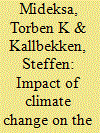

|
|
|
|
|
| Publication |
2010.
|
| Summary/Abstract |
Climate change will impact electricity markets through both electricity demand and supply. This paper reviews the research on this topic. Whereas there is much that remains unknown or uncertain, research over the last few years has significantly advanced our knowledge. In general, higher temperatures are expected to raise electricity demand for cooling, decrease demand for heating, and to reduce electricity production from thermal power plants. The effect of climate change on the supply of electricity from non-thermal sources shows great geographical variability due to differences in expected changes to temperature and precipitation. Whereas the research frontier has advanced significantly in the last few years, there still remains a significant need for more research in order to better understand the effects of climate change on the electricity market. Four significant gaps in the current research are regional studies of demand side impacts for Africa, Asia, the Caribbean and Latin America, the effects of extreme weather events on electricity generation, transmission and demand, changes to the adoption rate of air conditioning, and finally, our understanding of the sensitivity of thermal power supply to changes in air and water temperatures.
|
|
|
|
|
|
|
|
|
|
|
|
|
|
|
|
| 10 |
ID:
178923
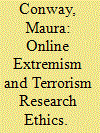

|
|
|
|
|
| Summary/Abstract |
This article reflects on two core issues of human subjects’ research ethics and how they play out for online extremism and terrorism researchers. Medical research ethics, on which social science research ethics are based, centers the protection of research subjects, but what of the protection of researchers? Greater attention to researcher safety, including online security and privacy and mental and emotional wellbeing, is called for herein. Researching hostile or dangerous communities does not, on the other hand, exempt us from our responsibilities to protect our research subjects, which is generally ensured via informed consent. This is complicated in data-intensive research settings, especially with the former type of communities, however. Also grappled with in this article therefore are the pros and cons of waived consent and deception and the allied issue of prevention of harm to subjects in online extremism and terrorism research. The best path forward it is argued—besides talking through the diversity of ethical issues arising in online extremism and terrorism research and committing our thinking and decision-making around them to paper to a much greater extent than we have done to-date—may be development of ethics guidelines tailored to our sub-field.
|
|
|
|
|
|
|
|
|
|
|
|
|
|
|
|
| 11 |
ID:
175709
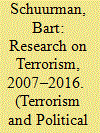

|
|
|
|
|
| Summary/Abstract |
Research on terrorism has long been criticized for its inability to overcome enduring methodological issues. These include an overreliance on secondary sources and the associated literature review methodology, a scarcity of statistical analyses, a tendency for authors to work alone rather than collaborate with colleagues, and the large number of one-time contributors to the field. However, the reviews that have brought these issues to light describe the field as it developed until 2007. This article investigates to what extent these issues have endured in the 2007–2016 period by constructing a database on all of the articles published in nine leading journals on terrorism (N = 3442). The results show that the use of primary data has increased considerably and is continuing to do so. Scholars have also begun to adapt a wider variety of data-gathering techniques, greatly diminishing the overreliance on literature reviews that was noted from the 1980s through to the early 2000s. These positive changes should not obscure enduring issues. Despite improvements, most scholars continue to work alone and most authors are one-time contributors. Overall, however, the field of terrorism studies appears to have made considerable steps towards addressing long-standing issues.
|
|
|
|
|
|
|
|
|
|
|
|
|
|
|
|
| 12 |
ID:
117901
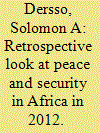

|
|
|
|
|
| Publication |
2013.
|
| Summary/Abstract |
Apart from existing conflicts in places such as Sudan and Somalia, in 2012 Africa witnessed the eruption of major armed conflicts involving rebel groups and a rise in emerging threats to security particularly terrorism and other forms of transnational threats. In providing an analytical review of these developments and their implications for the peace and security trends of Africa, this article points out that while the number and persistence of conflicts in Africa has in general been on decline, various parts of the continent continue to experience serious challenges to peace and security. Governance-related problems (notably serious democratic deficits and horizontal inequalities) and state fragility constitute the two common features of almost all of the existing and new crises affecting the continent in 2012.
|
|
|
|
|
|
|
|
|
|
|
|
|
|
|
|
| 13 |
ID:
155261
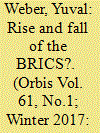

|
|
|
|
|
| Summary/Abstract |
The post-Cold War world defined by the spread of Euro-Atlantic institutions, practices, and values across the rest of the world has come to an end. Russia’s projections of military force abroad, Western populations voting to assert national sovereignty over transnational integration, and the economic powerhouses of Asia, China and India, delivering enviable growth rates all demonstrate that a new political order is in the making.
|
|
|
|
|
|
|
|
|
|
|
|
|
|
|
|
|
|
|
|
|